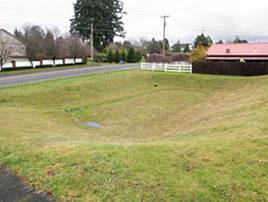
Difference between revisions of "BMPs for stormwater infiltration"
m |
m |
||
| Line 12: | Line 12: | ||
[[file:Infiltration basin 1.jpg|300px|thumb|left|alt=photo of an infiltration basin|<font size>Photo of an infiltration basin. Source: Clark County, Washington, with permission.</font size>]] | [[file:Infiltration basin 1.jpg|300px|thumb|left|alt=photo of an infiltration basin|<font size>Photo of an infiltration basin. Source: Clark County, Washington, with permission.</font size>]] | ||
| − | {| class="wikitable" style="float:right; margin-left: 10px; width: | + | {| class="wikitable" style="float:right; margin-left: 10px; width:300px;" |
|- | |- | ||
| colspan="2" style="text-align: center;" | '''Applications'''</font size> | | colspan="2" style="text-align: center;" | '''Applications'''</font size> | ||
Revision as of 21:44, 21 May 2015
Best Management Practices that infiltrate stormwater runoff into underlying soil include, but are not limited, to
- infiltration basins,
- infiltration trenches,
- underground infiltration,
- bioinfiltration,
- permeable pavements, and
- tree trenches and tree boxes.
These are discussed briefly below.
Infiltration basin
| Applications | |
| Residential | yes |
| Commercial | Yes |
| Unltra-urban | Limited1 |
| Industrial | Yes2 |
| Highway/road | Limited |
| Recreational | Yes |
| Treatment capabilities3, 4, 5 | |
| TSS | High6 |
| TN | Medium/high |
| TP | Medium/high |
| Chloride | Low |
| Metals | High |
| Oils and grease | High |
| Pathogens | High |
| 1 Due to a size restriction 2 Unless the infiltration practice is located in an industrial area with exposed significant materials or from vehicle fuelling and maintenance areas. Infiltration BMPs are PROHIBITED in these areas. | |
An infiltration basin is a natural or constructed impoundment that captures, temporarily stores, and infiltrates a design volume of water.
